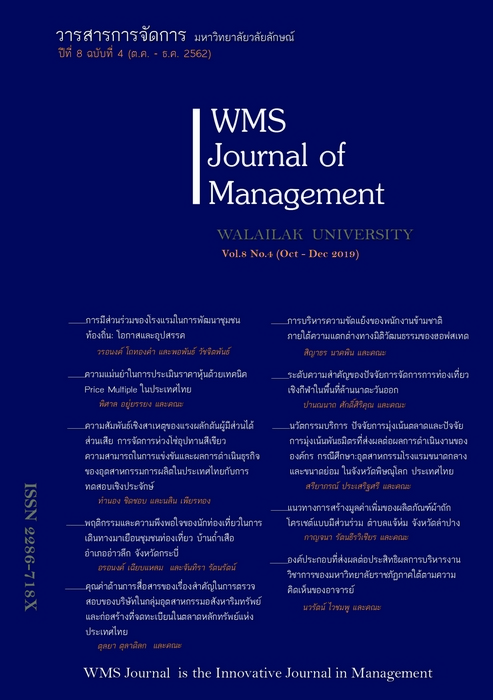Conflict Management of Expatriates under Hofstede’s Cultural Dimension Differences
Main Article Content
Abstract
This article aims to present circumstances regarding conflict management of expatriates based upon Hofstede’s cultural dimension differences by reviewing terms and roles of expatriates which are considered as the heart of international business. In business expansion of multinational corporations, expatriates are normally sent to overseas branch offices, which is common for conflicts to arise from cultural differences. A study of Hofstede’s different cultural dimensions therefore is a way which reflects six different cultural dimensions: Power Distance, Individualism/Collectivism, Masculinity/ Femininity, Uncertainty Avoidance, Long Term Orientation, and Indulgence/Restrained. Learning and understanding cultural differences in each dimension will be beneficial in proposing an important guideline for the conflict management of expatriates under cultural differences, which can result in effective performance that leads to success in international business.
Article Details
References
Andreassi, J. K., Lawter, L., Brockerhoff, M., & Rutigliano, P.J. (2014). Cultural Impact of Human Resource Practices on Job Satisfaction. Cross Cultural Management, 21(1), 55-77.
Chat-uthai, M. (2015). A Comparative Study and Survey of Multi-Cultural Dimensions in Thailand and Asia-Pacific Countries. NIDA Business Journal, 9(16), 60-81.
Chienwattanasook, K. (2010). The Impact of Employees’ Conflict Management Styles on Task Conflict, Relationship Conflict and Stress in the Thai Telecommunications Sector. Journal of Behavioral Science, 16(2), 13-31.
Chitakornkijsilp, P. (2003). Human Resource Management in International Business. Thai Journal of Development Administration, 43(3), 31-84.
Cullen, J.B., & Parboteeah, K.P. (2008). Multinational Management: A Strategic Approach. USA: Thomson South-Western.
Darawong, C. (2013). Expatriate Management for the era of ASEAN Free Trade. Journal of Business Administration, 36(138), 28-39.
Darawong, C. (2016). Managing Conflict between Engineers/R&D and Marketers in New Product Development Process. Executive Journal, 36(1), 3-13.
Dartey-Baah, K. (2013). The Cultural Approach to the Management of the International Human Resource: An Analysis of Hofstede’s Cultural Dimensions. International Journal of Business Administration, 4(2), 39-45.
Detnakarin, S., & Rurkkhum, S. (2015). The Effects of Cultural Dimensions on a High Performance Work System: An Integrative Literature Review. Journal of Management Sciences, 32(2), 199-225.
Duangsoongnern, K. (2013). Working Conditions in Firms Managed by Foreigners and Located in Nakhonratchasima Province. Journal of Management Sciences, 30(2), 27-49.
Hofstede, G. (1984). Culture’s Consequences: International Differences in Work-Related Values. (2nd ed.). Beverly Hills CA: Sage Publications.
Hofstede, G., Hofstede, G.J., & Minkov, M. (2010). Cultures and Organizations: Software of the Mind. (3rd ed). New York: McGraw-Hill.
Jongthammanurak, N. (2001). Conflict Management Strategies for Nursing Administrators. The Thai Journal of Nursing Council, 16(4) 41-51.
Kakhay, K. (2012). A Study of Capacity of Chief Executive in Government Sector and Private Sectors Management. Suan Sunandha Rajabhat Universit,Thailand.
Manotangworapan, N. (2010). Business Cultures in Asia-Pacific Countries. Executive Journal, 30(3), 31-36.
Monataraphadung, S. (2016). Creative Conflict Management. Valaya Alongkorn Review (Humanities and Social Science), 6(2), 193-208.
Moore, C.W. (2014). The Mediation Process: Practical Strategies for Resolving Conflict. (4thed). San Francisco: Jossey-Bass.
Napathorn, C. (2017). Human Resource Strategy of Service Multinational Corporations: The Case of Dusit International. Chulalongkorn Business Review, 39(152), 1-26.
Nirunkeit, S. (2013). Managing Conflict to Achieve the Most Effective Goal. Police Education Bureau.
Nontakaew Ferry, K., & Luekitinan, W. (2018). Human Resource Management of Multinational Enterprises in Laos PDR: A Case Study of Savan-seno Special Economic Zone. NRRU Community Research Journal, 12(1), 42-55.
Panyapong, S., Chamruspanth, V., & Laohasiriwong, W. (2012). Conflict between Local Community and Pubilc Organizations on Water Management from Lampatao Dam, Kaengkhro District, Chaiyaphum Province. Journal of Mekong Societies, 8(1),115-135.
Pojsupap, T., & Khasasin, R. (2017). Human Resource Issues and Challenges for International Business. Panyapiwat Journal, 9(3), 242-254.
Robbins, S.P., & Judge, T. (2013). Organizational Behavior. (15th ed.). Boston: Pearson.
Ruangrit, P., & Noirit, S. (2017). Developing the Conflicts Management Model for School Administrators of Secondary School under the Office of Secondary Educational Service Area 20. Journal of Education, Mahasarakham University, 11(3), 98-107.
Samukkethum, S. (2010). Cultures and Conflict Management: A Comparative International Study. Journal of Politics, Administration and Law, 2(2), 35-71.
Sangchoey, T. (2012). Cross-Cultural Dimension Differences in Tourist Behavior. Journal of Humanities and Social Sciences, 31(5), 61-72.
Suteetorn, B. (2017). Conflict and Interpersonal Conflict Resolution. Executive Journal, 37(1), 54-67.
Thakore, D. (2013). Conflict and Conflict Management. IOSR Journal of Business and Management (IOSR-JBM), 8(6), 7-16.
The Board of Investment of Thailand. (2018). Foreign Direct Investment Statistics and Summary. Retrieved from http://www.boi.go.th/index. php?page=statistics_oversea_report_st.
Thomas, K.W., & Kilmann, R.H. (2010). Thomas-Kilmann Conflict MODE Instrument. USA: CPP, Inc.
Ting-Toomey, S. (1991). Culture, Face Maintenance, and Styles of Handling Interpersonal Conflict: A Study in Five Cultures. The International Journal of Coflict Management, 2(4), 275-296.
Vatanasapt, W. (2004). Conflict: Approaches and Aquipments for Resolving Conflicts. (3th ed). Nonthaburi: King Prajadhipok's Institute.
Wongnasri, P. (2015). Conflict and Conflict Management Concepts: Contexts in Thai Society. Thaksin University Library Journal, 4(1), 59-81.
Wongwanich, B., & Laohavichien, T., (2017). Conflict Management and Organizational Citizenship Behavior. RMUTT Global Business and Economics Review, 12(2), 33-45.
Yenjaima, R, & Suyaporm, S. (2018). Conflict in Society: Theory and Solution. Journal of MCU Social Science Review, 7(2), 224-238.
Yirik, S., Yildirim, B.I., & Çetinkaya, N. (2015). A Study on Conflict Management and Conflict Resolution in Hospitality Organizations. International Journal of Arts & Sciences, 8(8), 77-88.
Yoo, B., Donthu, N., & Lenartowicz, T. (2011). Measuring Hofstede’s Five Dimensions of Cultural Values at the Individual Level: Development and Validation of CVSCALE. Journal of International Consumer Marketing, 23(3-4), 193-210.


